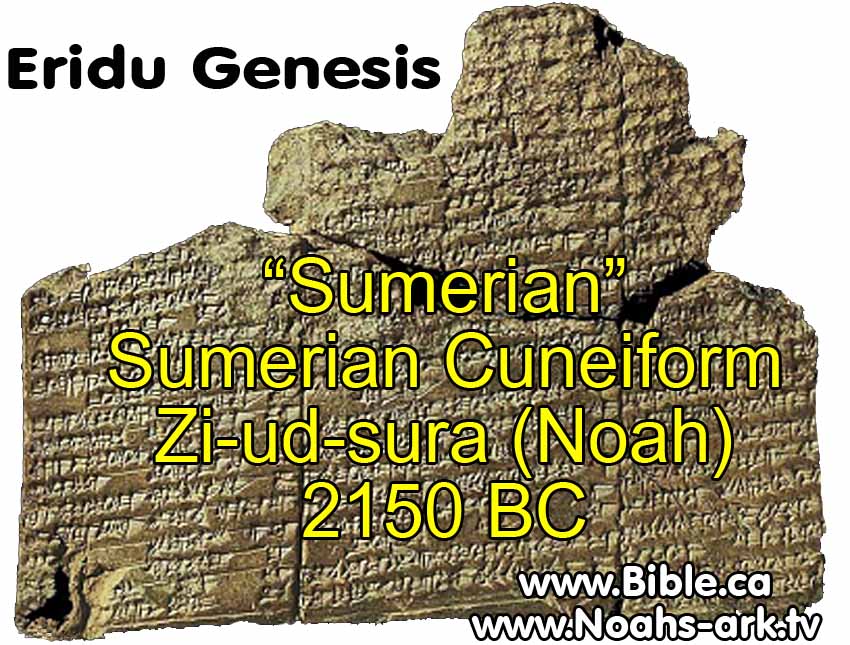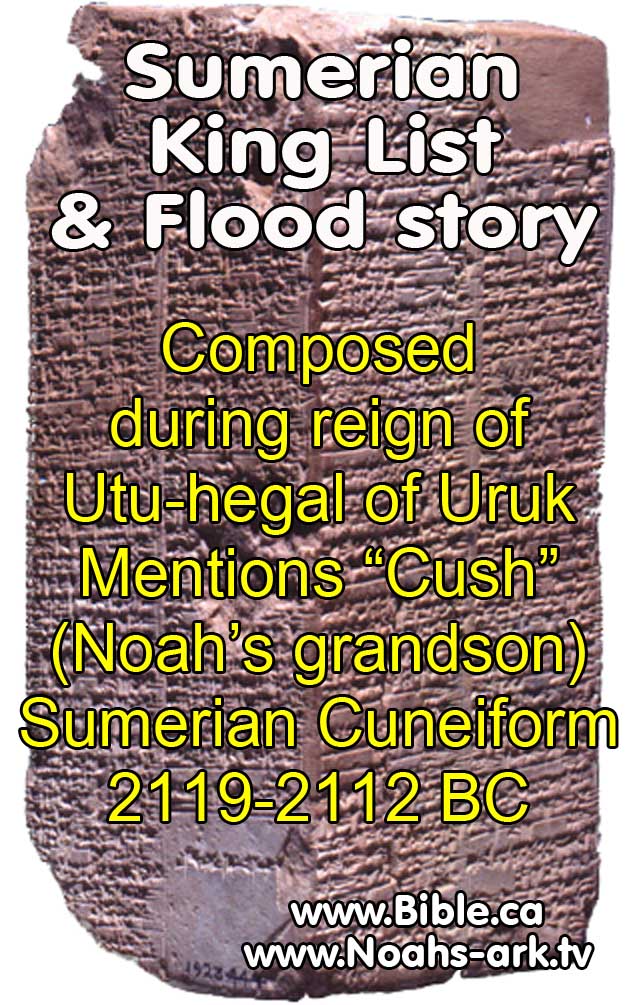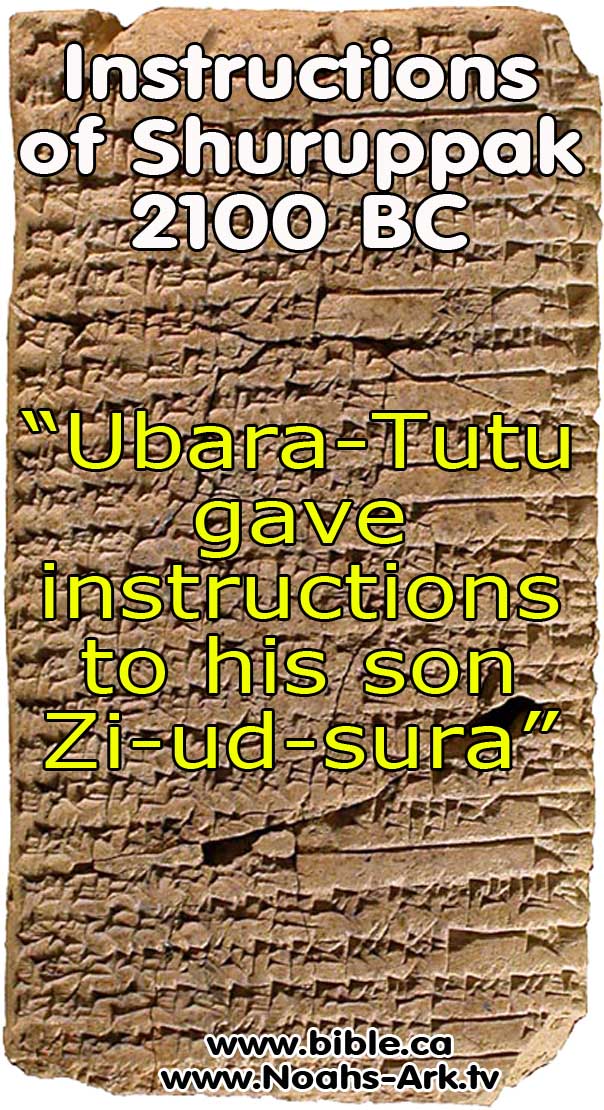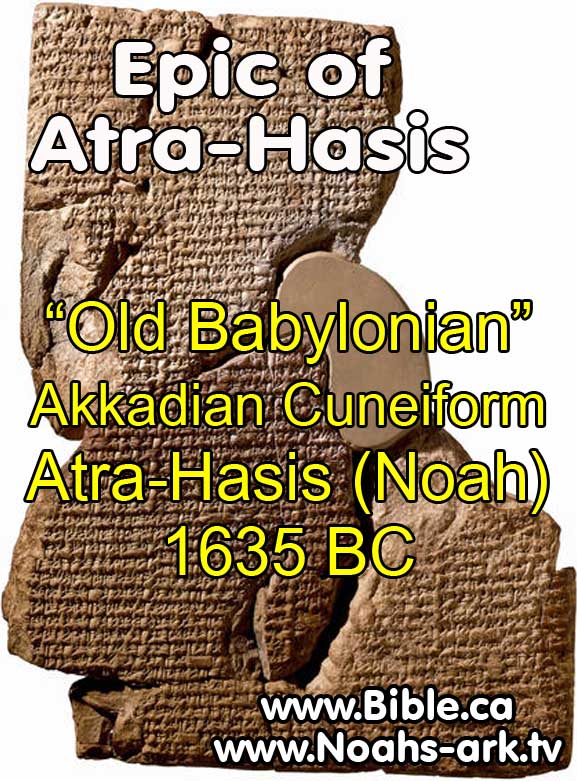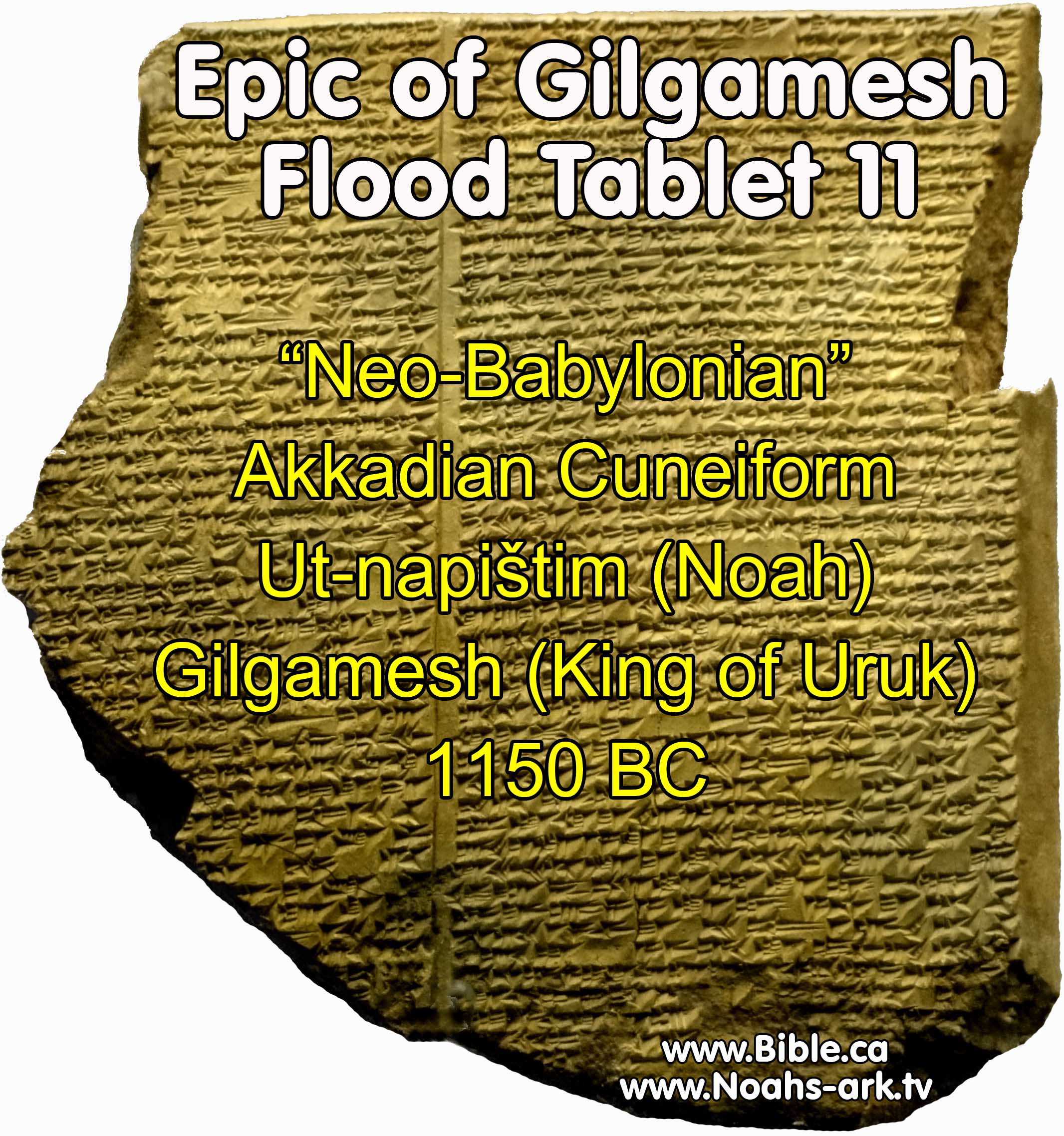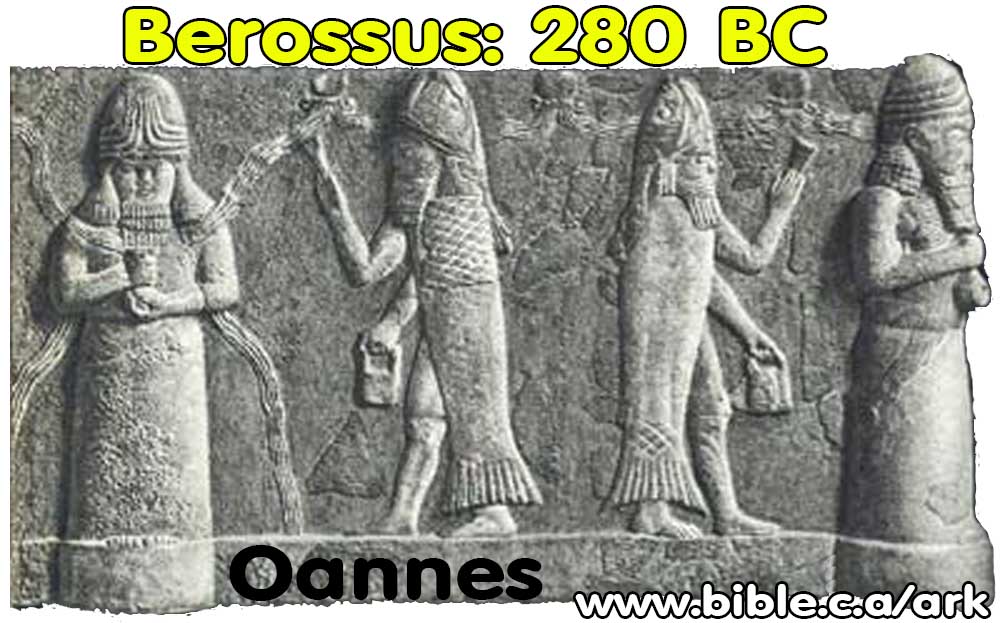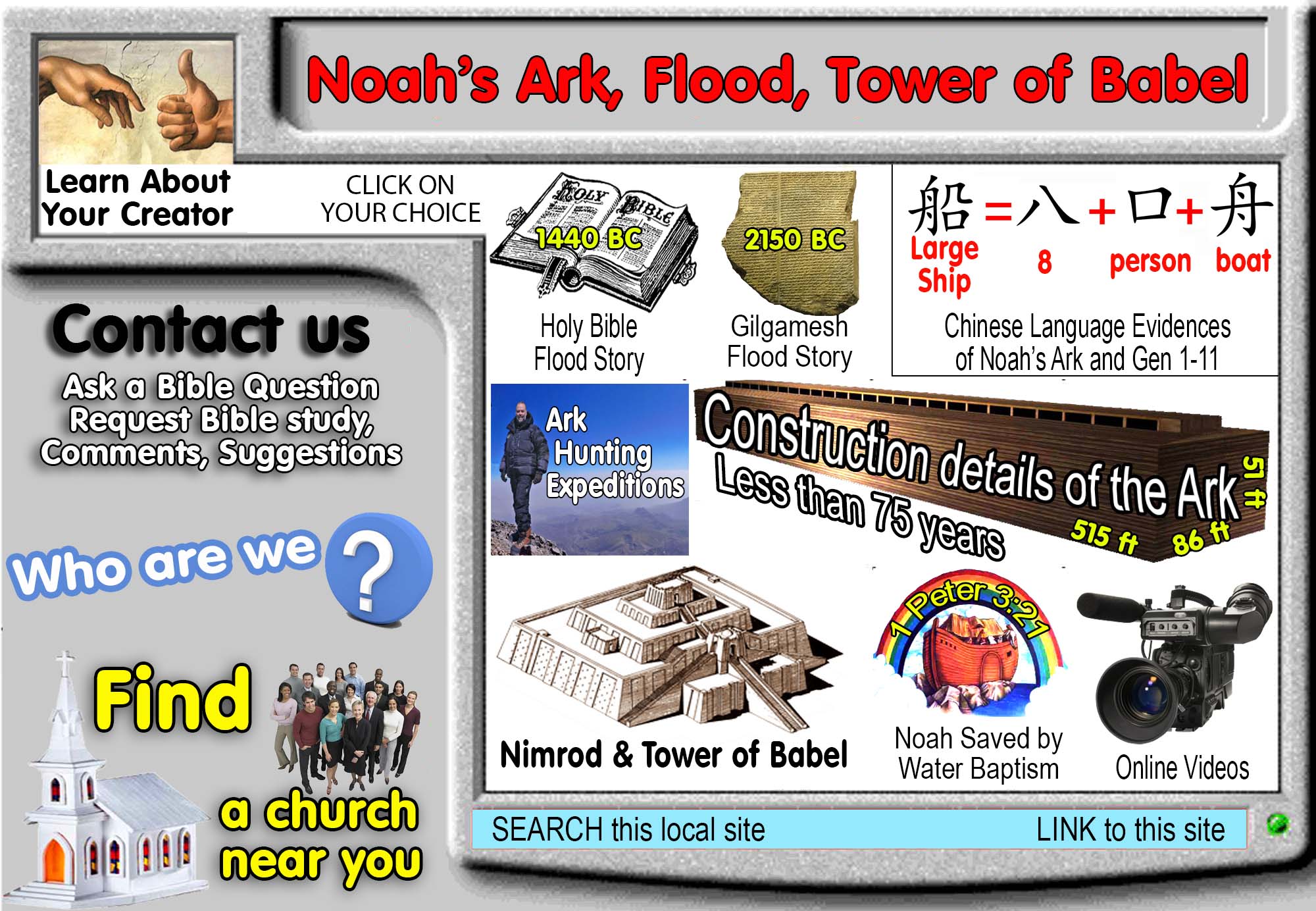The Search for Noah's Ark with Steven Rudd
|
500 Flood stories prove Noah's Ark is real history! |
Introduction: They are digging up Bible stories!
No matter what evidence you will present to atheists and Bible scoffers, they are going to say that Noah's Ark is a myth because they refuse to believe in God. Before the discovery of these tablets, atheists and Bible scoffers claimed that Noah's Ark was a myth because, they said, "if the entire world was really populated by four 'Adam and Eve like' couples upon exiting Noah's Ark, such a fact would be universally believed by all cultures on earth." When the news of the first flood story from Tablet 11 of the Gilgamesh Epic was published in 1872 AD, the skeptics, refusing to accept the obvious conclusion to their initial argument, suddenly made an about face. After the discovery of these tablets, skeptics now claimed that the Bible copied the story of Noah's Ark from the earlier sources that were etched into Sumerian cuneiform some 700 years earlier. While this is a logical argument, given some of the stunningly precise details all the stories share, it is an equally logical argument that since Noah's Ark is real history, we would predict that non-biblical writers would document the event. Therefore, the Epic of Gilgamesh reinforces the faith that a Christian has that the Bible is God's inspired word. These same Bible scoffers once decried the Hittite nation as just another Bible myth, until they were silenced by the discovery of 10,000 clay tablets in 1906 AD and excavated by Hugo Winckler. Today we know of over 500 ubiquitous flood stories from every culture in every corner of the globe from the present dating back to the dawn of writing. With the discovery of Noah's Ark skeptics are once again silenced until they invent another argument, like the boat was built as an ancient shrine. Such arguments will become marginalized and seen as radical when the size of the boat exactly matches that of Noah's Ark in Genesis 6. When professional excavations begin on Noah's Ark, the world may be stunned with the possible discovery of pre-flood tablets written in an unknown language signed by Noah, piles of extinct pre-historic plants that Noah used as food, even a few frozen, fully fleshed dinosaurs that never made it off the ark. Such a find would turn the world upside down with the collapse Darwinian evolution. Suddenly the Genesis becomes the introductory reading assignment in all university science and history courses. Bible scoffers and unbelievers will always reject the Bible at God's word until the day they stand before Him in Judgment after the second coming of Jesus Christ our Creator.
A. The global flood from the oldest archeology on earth:
|
|
|
|
|
|
|
|
|
Exhibit |
||||||
|
Name |
||||||
|
Date of tablet |
2150 BC |
2119-2112 BC |
2100 BC |
1635 BC |
1150 BC |
280 BC |
|
Language |
Sumerian Cuneiform |
Sumerian Cuneiform |
Akkadian Cuniform |
Akkadian Cuneiform |
Akkadian Cuneiform |
Greek |
|
Noah figure |
Zi-ud-sura "he obtained immortality" |
Cush, Noah's grandson |
Zi-ud-sura "he obtained immortality" |
Atra-Hasis "he who is very wise" |
Ut-napištim "he obtained immortality" |
Xisuthrus "he obtained immortality" |
|
Country |
Šuruppuk |
Šuruppuk |
Šuruppuk |
Šuruppak |
Šuruppak |
Sippar |
|
Destroyer God |
An and Enlil |
- |
- |
An and Enlil |
An and Enlil |
- |
|
Mutinous god who warned of flood |
Enki |
- |
- |
Enki |
Enki |
Enki |
|
Where tablets found |
Nippur, Iraq |
Larsa, Iraq |
Abu Salabikh Iraq |
Sippar, Iraq |
Nabu, Iraq Nineveh, Turkey |
Quoted by Josephus etc. |
|
Museum |
Pennsylvania Museum: Object B10673 |
Ashmolean Museum in Oxford, England |
Iraq Museum, Baghdad (looted 2003) |
British Museum Room 56 |
British Museum, Room 55 |
No originals. |
|
More Details |
Sumerian Kings |
B. Overview of similarities that flood stories share with the Bible:
|
1440 BC |
Sumerian Eridu 2150 BC |
1635 BC |
1150 BC |
2275 BC |
|
Man created with clay and spirit of god Gen 2:7 |
Tablets damaged |
|
Enkidu is a created god that becomes human |
"living dust man" |
|
Garden paradise Gen 2:8 |
Tablets damaged |
no |
Ut-napištim the immortal man lives in garden |
"Enclosure with 4 rivers" Or "perfect garden" |
|
Tree of eternal life Gen 2:9 |
Tablets damaged |
no |
Gilgamesh picks leaves from a plant that gives eternal life |
"2 trees + woman" |
|
Snake responsible for man losing Tree of life Gen 3:1 |
Tablets damaged |
no |
Snake eats plant of eternal life and Gilgamesh remains mortal. |
"Covered + devil + 2 trees" |
|
Curse of childbirth pain Gen 3:16 |
Tablets damaged |
|
no |
"2 trees + 1 man" |
|
Curse of Hard labour Gen 3:17 |
Tablets damaged |
|
no |
"Ancient weeds" |
|
Ship was built Gen. 6:14 |
|
|
|
"8 person boat" |
|
Large Ship dimensions Gen 6:15 300x50x30 cubits |
Tablet damaged but it was a large shaped like a blimp or football
|
150x150x150 cubits (Atra-Hasis) 2083 x 833 cubits (Berossus) |
No dimensions given but it was a small boat
|
- |
|
Bitumen (pitch) used on Ship Gen. 6:14 |
|
|
|
- |
|
God brings animals to ark Gen 6:20 |
Tablet damaged |
Enki attracts animals to boat with rain |
No indication. |
- |
|
Food was stored Gen. 6:21 |
|
|
|
- |
|
Animals in ark Gen. 7:8-9 |
|
|
|
- |
|
Family on Ship Gen. 7:1-10 |
Tablet damaged |
|
|
"8 men on a boat" |
|
Waited 7 days for flood Gen 7:10 |
Tablet damaged |
|
no |
- |
|
Single door sealed with pitch Gen 7:16 |
Tablet damaged |
Atra-Hasis closes and seals door |
Ut-napištim closes and seals door |
- |
|
Global flood covered the Mountains Gen. 7:20-22 |
Tablet damaged |
|
|
- |
|
The ark rested on a mountain Gen 8:4 Mt. Ararat |
Tablet damaged |
Tablet damaged |
Mt. Nimush, Gilgamesh. (Corcyrćan mountains of Armenia, Berossus) |
- |
|
Ship had a Window Gen. 6:8 |
Zi-ud-sura Drilled hole |
Tablet damaged |
|
- |
|
4 birds sent out 7 days apart Gen. 8:6-12 Raven, 3 doves |
Tablet damaged |
Tablet damaged |
doves, swallow, raven |
- |
|
Raven, dove, dove Gen 8:7 |
Tablet damaged |
Tablet damaged |
Dove, swallow, Raven |
- |
|
Altar used in sacrifice Gen. 8:20-22 |
|
|
|
- |
|
God pleased with Noah's altar sacrifice Gen. 8:20 |
|
|
|
"man through whom the weed curse is removed" |
|
Animals afraid of man after flood Gen 9:2 |
Tablet damaged |
Tablet damaged |
Animals afraid of divine Enkidu after he becomes man |
- |
|
Rainbow reminder of flood Gen 9:13 |
Tablet damaged |
Tablet damaged |
Bead necklace as a reminder of the flood |
- |
C. Similarities between Genesis and ancient flood accounts:
1.
Many flood stories, like Atra-hasis
(1635 BC), record how men seeking relief of their burdened of hard labour
before the flood because the gods had "cursed the ground". This
agrees with Genesis and the meaning of Noah's name: "Now he called
his name Noah, saying, "This one will give us rest from our work and from
the toil of our hands arising from the ground which the LORD has
cursed."" (Genesis 5:29) In Chinese, the name Noah means: "man
through whom the weed curse is removed".
![]()
2. Noah and two his counterparts in Gilgamesh (Ut-napištim) and the Sumerian Eridu (Zi-ud-sura, king and the Gudug priest) were all in close spiritual union with their God. Noah was seen as the righteous one who walked with God and Utnapishtim is seen as equally pious in obedience to his gods. The oldest version in the world (Sumerian) has Zi-ud-sura as, "king and the Gudug priest. All three were rewarded by after they sacrificed upon leaving the ark.
3. Both Noah and Atra-Hasis were given explicit dimensions of the ark. The Sumerian tablet is damaged.
4. God gave mankind a 120 year period of grace through the preaching of Noah whereas such grace was completely absent from the Gilgamesh account where the impending destruction was a secret the gods wanted to keep even from Utnapishtim. However in the Atrahasis story, the god Enlil sent many plagues hoping to quiet the human noise that kept him awake. However Enlil's grace may have been more direct actions to reduce the population and therefore the noise, rather than a genuine period of grace like Noah and Moses offered in an effort to get moral repentance.
5. Both boats were coated inside and out with bitumen.
6. Only 8 persons were aboard Noah's ark Likewise in Gilgamesh, a small number of Ut-napištim's friends and family were saved.
7. Noah took 7 pairs of clean animals and 1 pair of all the rest, including birds, reptiles etc. with herbivores. In Atra-hasis and Gilgamesh loaded animals into the boat but there is no differentiation between clean and unclean animals.
8. Noah didn't have to go looking for the animals that went into the ark. God brought the animals to Noah, but we are not told how. In Atra-Hasis "Enki", the god of water (later Greek: Neptune) attracted the animals to the ark with rain.
9. All four flood stories speak of a global flood that rose above the mountains and that killed everything on earth. The oldest story, (Sumerian Eridu) is damaged but the indication is clear there was a global flood. The Bible says that the waters rose 15 cubits (22 feet) above the highest mountain.
10. Noah released four birds, seven days apart. First a raven that did not return, then two dove's that returned followed by a dove that did not return. In Gilgamesh also released three birds a dove, sparrow and raven. In the Berossus, Xisuthros releases several birds each time. In Gilgamesh, Ut-napištim releases a dove, then swallow, then a raven. Interesting that the biblical account of the order of the birds being released is scientifically correct in that a Raven, being a meat eater, is far more able to survive than a dove that is a delicate herbivore. Noah sent the stronger bird first and the weaker bird second whereas Utnapishtim did it in the opposite order.
11. All the flood accounts feature sacrifices upon leaving the ark. Noah offered one of every clean animal and bird which was a soothing aroma to God. In the oldest flood Sumerian Eridu flood story, Zi-ud-sura "the king sacrificed oxen and offered innumerable sheep." So both Genesis and the oldest Sumerian story agree that a large number of animals were sacrificed. InGilgamesh, Utnapishtim offers a bloodless sacrifice of sugar cane, cedar and myrtle of sweet smelling incense. In the Berossus, Xisuthros offers a sacrifice with no specific details.
12. God was appeased and moved to never destroy man again when he smelled Noah's sweet sacrifice whereas when the gods smelled the sweet sacrifice of Utnapishtim, they "gathered like flies" in a most base, undignified and animalistic manner as though they hadn't eaten in weeks. Even worse, when primary deity Enlil, arrived, he was prevented by the other gods from approaching the sacrifice because he had so rashly destroyed all of man. In the Bible, God is sorry for creating man and then sends the flood. In the Epic of Gilgamesh, Enlil is sorry for sending the flood then rebuked by other gods for doing so. In the Bible man is the sinner, in Gilgamesh god (Enlil) is the sinner. Remarkably, however, both stories arrive at that same conclusion that the earth would never be destroyed again in completely opposite manners.
13. All stories have God offering a blessing after they left the ark. God blessed Noah to have many children, and to start eating meat, but not blood. All of Noah's counterparts in the other flood stories were blessed with eternal life. Zi-ud-sura in Sumerian Eridu, Atra-Hasis in Atra-hasis, Utnapishtim in Gilgamesh all were blessed with eternal life.
14. God gave the rainbow as a reminder to Noah of the flood. Similarly in Gilgamesh, the god of the womb (Belet-Ili) arrives and presents Ut-anapishtim with a bead necklace as a reminder of the flood.
D. Literary evidences of inspiration of Genesis:
1. Genesis focuses on what happened to man on earth with very little imagery in heaven, whereas Gilgamesh focuses primarily on what the gods did in heaven and how their actions affected man as a consequence.
2. Typical of inspiration, the Holy Spirit is able to remained focused on the earthly matters that which man is familiar with and while avoiding heavenly matters that man desperately wants to know. Typical of non-inspired writings, man focuses on explaining and exploring those matters he desperately seeks but has no direct knowledge.
3. Genesis states that morality was the reason for the destruction of man, whereas in the Gilgamesh story, the gods destroyed the world as the result of an impulsive and rash choice and the Atra-Hasis story says that the gods were narcissistically disturbed from their sleep by the noise man was making on earth.
4. Genesis more realistically portrays the long drying period of the land which caused Noah to remain inside the boat. The statement that the land was dry is lacking in the Gilgamesh and Atra-Hasis stories.
5. The name "Noah" means "rest" in Hebrew, which has no direct relationship to the events of the flood, which is a proof of inspiration. Names used in myths always have some meaning to the storyline.
a. Noah's counterperson in Sumerian Eridu (2150 BC) is "Zi-ud-sura" which means "he obtained immortality".
b. Noah's counterperson in Gilgamesh (1150 BC) is "Ut-napištim" which means "he obtained immortality".
c. Noah's counterperson in Atra-Hasis (1635 BC) is "Atra-Hasis" which means "he who is very wise".
d. Noah's counterperson in Berossus (280 BC) of Atra-Hasis is "Ziusudra" which means "he who laid hold of life/immortality from long ago".
E. Differences between the ancient flood accounts and (Genesis):
1. Polytheism (vs. Biblical monotheism)
2. Mutiny, disagreement and betrayal between gods over the decision to send the flood. (The God of the Bible is one)
3. The gods broke oaths to each other in the "highest supreme court". (God never breaks his word and keeps all his promises)
4. Mankind was destroyed because his noise disturbed the god's sleep (Man was destroyed because of sin)
5. The decision to send the flood was spontaneous, shortsighted which lacked proper deliberation and later regretted. (God never regretted destroying the world with a flood and promised to destroy the world a second time with fire at the second coming of Jesus Christ)
6. The highest god, Enlil, is an imperfect sinner who is rebuked and defiantly challenged by lower gods. The pagan counterpart to satan becomes the hero of truth and righteousness and the savour of man, and the top god is the real satan and enemy of mankind. (God is perfect and sinless. The devil is a liar and there is no good in him.)
7. The highest god, Enlil offers eternal life because man deserved it, since Enlil had to make up for his own failures and bad decision to send the flood. (God offers us the free gift of eternal life even though we are worthless and do not deserve it Rom 5:8-10)
8. Those on the ark were saved purely for selfish reasons of the gods to man could continue do their work and they could get fed from the animal sacrifices. There was no compassion or care for man himself, only what man could to as slaves for the gods. (Jesus selflessly died on the cross for us out of grace so we would have a better life than we do on earth.)
9. The gods actually hate man, killing him off like vermin and pests. (God loves man and want to adopt us into his loving family)
10. The gods are dependent on man for survival through the food that animal sacrifices provided. When man stops sacrificing, the gods starve of hunger. (God does not need man for anything)
11. Man is told that in order for the gods to take notice of them, they must make lot of noise to wake up the gods. (God doesn't sleep and his eyes are always watching us every moment of the day.)
12. Man is told that if he wants to get his prayers answered from the gods, he must bug and annoy them and make them mad. (The prayers of Christians have a loving and open ear from God at all times)
13. In Gilgamesh, Utnapishtim's boat was a perfect cube of 120 x 120 x120 cubits [displacement 228,500 tons] with 7 decks with 9 vertical compartments (63 total) with one door and window. Atra-Hasis' boat was shaped like a large blimp. Berossus, who follows the Atra-Hasis account closely, has the ark utterly enormous being "five stadia in length, and two in breadth". This translates to a boat 3034 x 1213 feet or 833 x 2083 cubits! (Noah's Ark was 300 x 50 x 30 cubits [displacement 43,300 tons] with three decks, one door and window.)
14. The Gilgamesh flood lasted 6 days and the Sumerian flood lasted 7 days and the Berossus flood gives no timing details. (Noah's flood lasted 1 year and 11 days or 371 days)
15. In Gilgamesh , Utnapishtim had to launch the enormous cube boat himself, "The launching was very difficult. They had to keep carrying a runway of poles front to back, until two-thirds of it had gone into the water." Such a launching would clearly be impossible for a small group of men. Then Erragal, the god of the underworld, "pulled out the mooring poles". (The Bible says that the waters lifted Noah's Ark as the water rose.)
16. The gods said to build a boat with 7 floors (Noah's Ark had 3 floors)
17. Utnapishtim closes the boat door and seals it with pitch. (God closed the door on Noah's ark and sealed it with pitch)
18. The storm lasted 6 days, 7 nights. (Although there are several periods of 7 in the Bible flood story, the storm lasted 40 days and nights)
19. The order that the birds were released was different: Raven, sparrow, dove. (Noah released two doves and a raven)
20. After the flood, the gods are starving and parched because there were no men to feed them through sacrifice during the flood. All the gods "swarm like flies" to the sacrifice and eat their fill. Interesting that Jesus was accused of using the power of Beelzebub, the "lord of the flies" to cast out demons. (God does not rely on man for anything)
21. The gods act out of unjust revenge and unjustly killed off all men in the flood without any warning. (Noah preached to the people and warned them for up to 100 years. Those that dies rejected the warning).
22. The gods told Utnapishtim to preach lies to the doomed people by saying that the gods were unhappy with him and that he needed to leave town in a boat. In fact the gods were happy with Utnapishtim since he was the only one chosen to be warned and saved. (It is impossible for God to lie. Noah is called "a preacher of righteousness", no a preacher of lies.)
23. Gilgamesh is offered eternal life on the basis of meritorious works, if he can stay awake for 7 continuous days, which is extraordinary for any man to do. Very, very few people on earth could do what the gods commanded to attain eternal life. (Jesus offers us eternal life as a free gift based upon grace and not meritorious works we do to earn it. When we are commanded to be baptized for the remission of sins [Ml 16:16; Acts 2:38; 22:16; 1 Pe 3:21[, it is something common, easy and something men to do. Being immersed in water is something people have done thousands of times swimming, bathing etc. Anybody can obey the command to be baptized)
24. The Gilgamesh flood story starts with man searching for the purpose of life and how mortals can attain eternal life. It ends in with a message of hopelessness since there is no way for man to gain eternal life. Gilgamesh goes home "empty handed" deflated, depressed and without hope to his home where he lives out his life and dies. Even though the story doesn't mention his death. (The Genesis story offers hope, eternal life, blessing and promises two chapters after the flood with the promises made to Abraham.)
25. In the Atrahasis account, on the other hand, the gods created 7 mated pairs of humans to speed up the repopulation process. (The Genesis account shows the natural repopulation of the earth through Noah's three sons and how they became the father of many specific nations known to archeology.)
The global flood from the oldest archeology on earth:
|
|
|
|
|
|
|
|
|
Exhibit |
||||||
|
Name |
||||||
|
Date of tablet |
2150 BC |
2119-2112 BC |
2100 BC |
1635 BC |
1150 BC |
280 BC |
|
Language |
Sumerian Cuneiform |
Sumerian Cuneiform |
Akkadian Cuniform |
Akkadian Cuneiform |
Akkadian Cuneiform |
Greek |
|
Noah figure |
Zi-ud-sura "he obtained immortality" |
Cush, Noah's grandson |
Zi-ud-sura "he obtained immortality" |
Atra-Hasis "he who is very wise" |
Ut-napištim "he obtained immortality" |
Xisuthrus "he obtained immortality" |
|
Country |
Šuruppuk |
Šuruppuk |
Šuruppuk |
Šuruppak |
Šuruppak |
Sippar |
|
Destroyer God |
Enlil |
- |
- |
Enlil |
Enlil |
Enlil |
|
Mutinous god who warned of flood |
Enki |
- |
- |
Enki |
Enki |
Enki |
|
Where tablets found |
Nippur, Iraq |
Larsa, Iraq |
Abu Salabikh Iraq |
Sippar, Iraq |
Nabu, Iraq Nineveh, Turkey |
Quoted by Josephus etc. |
|
Museum |
Pennsylvania Museum: Object B10673 |
Ashmolean Museum in Oxford, England |
Iraq Museum, Baghdad (looted 2003) |
British Museum Room 56 |
British Museum, Room 55 |
No originals. |
|
More Details |
Sumerian Kings |
By Steve Rudd
Noah’s Ark, Flood and Tower of Babel
